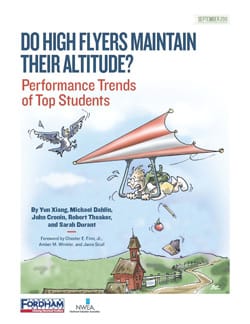Last week, Fordham released a groundbreaking new study on high-achieving students, titled Do High Flyers Maintain Their Altitude? Performance Trends of Top Students. In a series of Flypaper posts that followed, we examined the report's main findings: First, that three in five high-achieving students remain that way over time; second, that most students coming in and out of the 90th percentile never fall below the 70th percentile overall; and third, that high achievers maintain the same pace as middle and low achievers over time in math, but grow more slowly than middle and low achievers in reading.
 For those readers interested in more nuanced findings, I encourage you to poke around the report's data gallery, hosted by the Kingsbury Center at the Northwest Evaluation Association. Through the data gallery, you can break down these findings by grade range, subject, year, and even demographics?gender, ethnicity, poverty status, and location.
For those readers interested in more nuanced findings, I encourage you to poke around the report's data gallery, hosted by the Kingsbury Center at the Northwest Evaluation Association. Through the data gallery, you can break down these findings by grade range, subject, year, and even demographics?gender, ethnicity, poverty status, and location.
The future of our country rests on the shoulders of those high achievers in our schools today. While this study suggests that they are not in short supply, it also demonstrates that we could expand our pool of high achievers by identifying and supporting students with potential?many of those students above the 70th percentile overall?and by intervening before other students fall out of the high-achieving ranks. While this study has shed new light on the progress, missteps, and success of our nation's high flyers, it begs the question: What will we do to bolster their odds?
? Janie Scull
